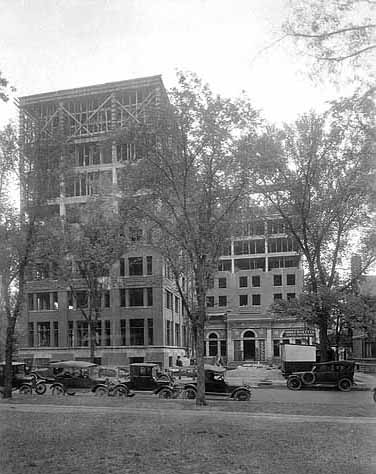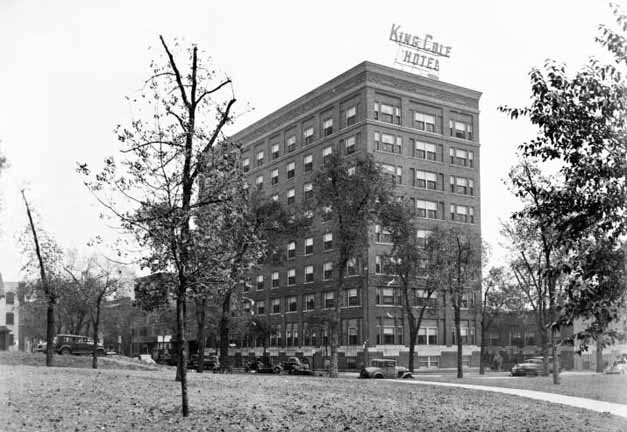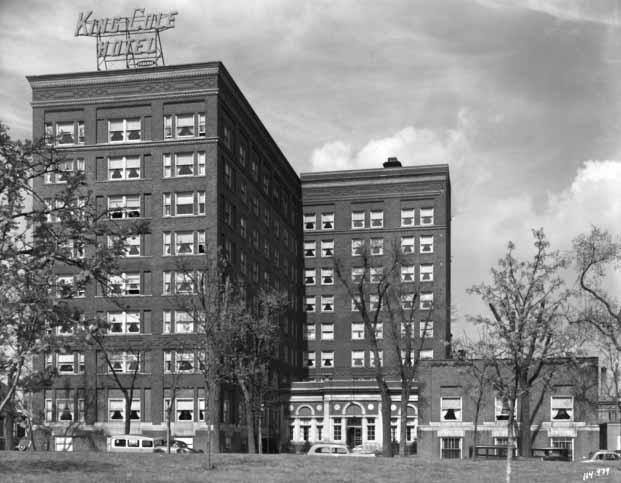King Cole Hotel
60 Willow Street at Yale Place
Minneapolis
The King Cole Hotel was located at 60 Willow Street at Yale Place, overlooking Loring Park.
LORING PARK CLINIC
The eight-story building was originally planned to be the Loring Park Clinic, housing a hospital, sanitarium, and medical clinic. The Loring Park Clinic was founded in 1911, in 1923 it was located in a three story, 32-room mansion at either 1508 or 1600 Harmon Place. It specialized in kidney stones, gallstones, and selling tea for weight reduction. The new building was meant to replace the crowded building, and it appears that shares were sold and court cases were filed.
NORDIC HOTEL
Next the Nordic Hotel Association, Inc., was formed to turn the building into a hotel. Construction was started in 1922, but for eight years the concrete skeleton stood without walls.

A headline reads “Work Speeded on New Nordic Hotel.” (Minneapolis Tribune, March 16, 1930). It was finished in late 1930, and the Association planned to furnish, equip, and operate it as a memorial to Norwegian-American pioneers. The building was completed except for the furnishings when the Association ran out of money, and went into foreclosure in 1931.
KING COLE HOTEL
In October 1934 the building was purchased by Peppard Properties, Inc. The new owner conducted a contest for a name and King Cole was chosen when the hotel opened on December 1, 1934. (Minneapolis Star, January 24, 1949).

However, a search of the Minneapolis papers finds a mention the King Cole Hotel on February 13, 1926. A different King Cole Hotel? Must be an anomaly, since the next mentions don’t start until January 1935.
Cedar Imboden Phillips has described it as “a destination for countless local celebrations and special events,” presumably with music involved. The social columns noted that guests to town stayed at the hotel; notorious guests included Bugsy Siegel, according to Phillips. Meetings were held there, and in the mid-1930s more dances began to be held at the hotel. These were all private affairs, sponsored by such groups as the Hanky Panky Club, an organization of magicians. Other common events were wedding receptions, class reunions, fraternity and sorority dances, etc.
In 1935, the murder of journalist Arthur Liggett spurred several police investigations. One was by the “Secret Six,” a group out of Chicago, headquartered at the King Cole Hotel. (Minneapolis Star, December 11, 1935)

In 1937 advertisements began to appear, telling us that the hotel had a swimming pool, “physical culture studio,” and a famous dining room. The hotel made much of its pool, offering swimming lessons.
In 1949 the building was purchased by the Salvation Army, which converted it into the Evangeline Residence for Girls, a residence for women between the ages of 17 and 35. Weekly rates started at $14 per week.
The building was wrecked in 1976 and replaced by Booth Manor, a senior high-rise also owned by the Salvation Army.


